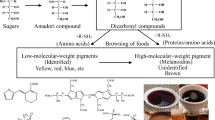Summary
Since the concentrations of phenylhydroxylamine and nitrosobenzene in the blood of cats and dogs are too low to produce all the hemiglobin observed following the injection of N,N-dimethylaniline, other meta-bolites were tested for their hemiglobin forming activity.
After the intravenous injection of 0.6 mMol N,N-dimethylaniline or N,N-diethylaniline per kg into dogs the hemiglobin concentration rose beyond 0.4 of the total blood pigment, and the N-oxides were found in the blood of dogs in concentrations of about 8 and 6 μg/ml. These concentrations of the N-oxides in the blood of dogs, when produced by intravenous infusion of the N-oxides, did not raise the hemiglobin concentration. Therefore, the N-oxides are not the metabolites that form the hemiglobin observed after the absorption of N,N-dialkylanilines.
p-Dimethylaminophenol, a metabolite of N,N-dimethylaniline, was found to be highly active in forming hemiglobin in vitro and in vivo. It is likely that it plays an important role in the hemiglobin formation following the absorption of N,N-dimethylaniline.
Similar content being viewed by others
References
Bamberger, E., u. P. Leyden: Weitere Beiträge zur Kenntnis des Dimethylanilinoxyds. Ber. dtsch. chem. Ges. 34, 12 (1901).
Belov, V. N., and K. K. Savich: Preparation of oxides of tertiary aromatic amines. Methyldiphenylamine oxide. J. gen. Chem. (USSR) 17, 257 (1947); ref.: Chem. Abstr. 42, 530 (1948).
Elson, L. A., F. Goulden, and F. L. Warren: The metabolism of aromatic amines Biochem. J. 40, 29 (1946).
Hildebrandt, H.: Über das biologische Verhalten von Phenylalkylaminen und Phenylalkylammoniumbasen. Beitr. chem. Physiol. Path. 9, 470 (1907).
Holzer, H., u. M. Kiese: Bildung von Nitrobenzol, Anilin und Hämiglobin in Katzen und Hunden nach intravenöser Injektion von N-Alkylanilinen. Naunyn-Schmiedebergs Arch. exp. Path. Pharmak. 238, 546 (1960).
Horn, F.: Über den Abbau des Diäthylanilins und Diäthylanilinoxyds im Tierkörper. Hoppe-Seylers Z. physiol. Chem. 249, 82 (1937).
Kiese, M.: Empfindliche photometrische Verfahren zur Bestimmung von Hämiglobin. Naunyn-Schmiedebergs Arch. exp. Path. Pharmak. 204, 190 (1947).
—— Die Bedeutung der Oxidation von Anilin zu Nitrosobenzol für die Hämiglobinbildung nach Aufnahme von Anilin. Naunyn-Schmiedebergs Arch. exp. Path. Pharmak. 235, 360 (1959).
-- Autocatalytic hemiglobin formation by N,N-dimethylniline-N-oxide. In preparation (1966).
Kiese, M., and M. Pekis: The reaction of p-aminophenol with hemoglobin and oxygen in vivo and in vitro. Naunyn-Schmiedebergs Arch. exp. Path. Pharmak. 246, 413 (1964).
——, and M. Rachor: The reaction of several aminophenols with hemoglobin and oxygen in vitro and in vivo. Naunyn-Schmiedebergs Arch. exp. Path. Pharmak. 249, 225 (1964).
——, u. M. Soetbeer: Kinetik der Hämiglobinbildung. I. Hämiglobinbildung durch Phenylhydroxylamin in vivo. Naunyn-Schmiedebergs Arch. exp. Path. Pharmak. 207, 426 (1949).
Lintzel, W.: Untersuchungen über Trimethylammoniumbasen. III. Trimethyl-ammoniumbasen im menschlichen Harn. Biochem. Z. 273, 243 (1934).
Stedman, E.: Studies on the relationship between chemical constitution and physiological action. Part I. Position isomerism in relation to the mitotic activity of some synthetic urethanes. Biochem. J. 20, 719 (1926).
Terayama, H.: Aminoazo dye amine-N-oxide as a possible intermediate metabolite preceding N-demethylation and ortho-hydroxylation, as well as azo dye-protein binding. Gann 55, 195 (1963).
Ziegler, D. M., and F. H. Pettit: Formation of an intermediate N-oxide in the oxidative demethylation of N,N-dimethylaniline catalyzed by liver microsomes. Biochem. biophys. Res. Commun. 15, 188 (1964).
Author information
Authors and Affiliations
Rights and permissions
About this article
Cite this article
Kiese, M., Rauscher, E. & Weger, N. The role of N,N-dimethylaniline-N-oxide in the formation of hemiglobin following the absorption of N,N-dimethylaniline. Naunyn-Schmiedebergs Arch. Pharmak. u. Exp. Path. 254, 253–260 (1966). https://doi.org/10.1007/BF00536223
Received:
Issue Date:
DOI: https://doi.org/10.1007/BF00536223




